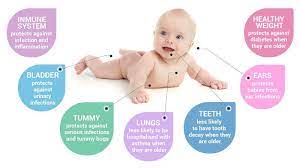Benefits of Breast Feeding
Breastfeeding is one of the most important feeding methods for babies from birth to 6 months of age. For babies, breast milk is an ideal food. It can provide all the energy and nutrition the baby needs in the first few months, and it can last until the age of two. It is clean, safe and nutritious, and contains all the necessary antibodies to help children reduce their risk of illness. According to the recommendations of the American Academy of Pediatrics (AAP) and the American College of Obstetricians and Gynecologists, exclusive breastfeeding is recommended for six months without any formula milk, juice or water [1]. However, 2 out of 3 babies are not breastfed during the first six months of life, and this rate has not improved within 20 years [2].
Human milk nutrition ratio:
The nutrients in the milk of each breed are the same, but the ratio is different, depending on the needs of each breed's young. In most cases, milk and formula milk are considered as substitutes for breast milk, but their nutrient ratios are different, and young people need different nutrients. Comparison of people and milk
|
|
Human milk |
Cow milk |
|
Protein |
1.3% |
3.3% |
|
Fat |
4.1% |
3.9% |
|
Carbohydrates |
7% |
4.5% |
|
Water |
88% |
88% |
Breast milk contains less protein and more fat, because fat is needed for the rapid development of the brain and nerves. Calves need to grow quickly, so milk has more protein and less fat. Therefore, milk is made for the development and growth of calves, while human milk is made for the development and growth of babies [3].
Breast milk needs change as the baby grows. Newborns are fed after 2-3 hours, 2-month-old babies are fed after 3-4 hours, and 6-month-old babies are fed after 4-5 hours [1].
The benefits of breastfeeding for babies:

Breast milk is a mixture of various nutrients needed for baby growth, such as protein, fat, carbohydrates, vitamins and minerals.
Breast milk contains antibodies that help fight viruses and bacteria.
Reduce the risk of asthma, allergies, ear infections, respiratory diseases and diarrhea.
Breastfeeding children have higher IQs, and their weight will increase as they grow up.
According to AAP, breastfeeding reduces the risk of SIDS (Sudden Infant Death Syndrome).

It reduces the risk of diabetes, obesity and certain cancers, but more research is needed.
The benefits of breastfeeding for mothers:
Breastfeeding helps burn calories faster, burning an extra 500 calories a day.
It helps the uterus reach its pre-pregnancy size and reduces uterine bleeding after birth.
It will reduce the chance of breast and ovarian cancer.
It can also reduce the mother's risk of osteoporosis.
Breastfeeding can reduce the risk of postpartum depression and anemia [4].
The ABC of breastfeeding:
There are some breastfeeding techniques called ABCs that can help babies get along with their mothers more comfortably.
Awareness: In this table, babies are fed when they are hungry, also known as on-demand feeding.
Be patient: Do not urge your baby when breastfeeding, as long as they feed every time they want to breastfeed. It usually takes 10-20 minutes on both sides of the baby’s breasts.
Comfort: Relaxation during breastfeeding will increase the process of sagging and flow [1].
References:
1-Grow by WebMD. (2020, september 14). Breastfeeding. Retrieved november 5, 2021, from Grow by WebMD: https://www.webmd.com/parenting/baby/nursing-basics#1
2-world health organisation. (n.d.). heallth topics breast feeding. Retrieved from world health organisation: https://www.who.int/health-topics/breastfeeding#tab=tab_1
3-TMR international. (2019, august 7). Difference between human milk and cow milk. Retrieved november 4, 2021, from TMR international: https://tmrinternational.org/why-you-should-not-give-your-baby-cow-or-any-animal-milk/
4-Cleveland Clinic. (2018, january 1). The benefits of breastfeeding for baby and for mom. Retrieved november 4, 2021, from Cleveland Clinic: https://my.clevelandclinic.org/health/articles/15274-the-benefits-of-breastfeeding-for-baby--for-mom




